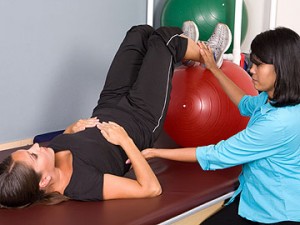Exercising To Prevent and Treat Back Pain
- Posted on: Oct 1 2014
A typical response to experiencing back pain is to take it easy. Most people will either stay in bed or at least discontinue any activity that is strenuous. While this approach is understandable and may even be recommended in the short term, when done for more than a day or two it can actually undermine healing. Instead, active forms of back exercises are almost always necessary to rehabilitate the spine and help alleviate back pain. With more than 25 years of clinical experience in the diagnosis, treatment, and documentation of injuries sustained by patients involved in all types of accidents (including work accidents, automobile accidents, slip and falls, and construction accidents), Dr. Jeff J. Mollins will often place his patients with back injuries on an effective treatment regimen that will typically include exercises as a vital part of their rehabilitation.
When done in a controlled, gradual, and progressive manner, active back exercises distribute  nutrients into the disc space and soft tissues in the back to keep the discs, muscles, ligaments, and joints healthy. Consequently, a regular routine of lower back exercises helps patients avoid stiffness and weakness, minimize recurrences of lower back pain, and reduce the severity and duration of possible future episodes of low back pain.
nutrients into the disc space and soft tissues in the back to keep the discs, muscles, ligaments, and joints healthy. Consequently, a regular routine of lower back exercises helps patients avoid stiffness and weakness, minimize recurrences of lower back pain, and reduce the severity and duration of possible future episodes of low back pain.
Almost everyone can benefit from stretching the soft tissues (muscles, ligaments, and tendons), the back, legs, buttock, and around the spine. The spinal column and its contiguous muscles, ligaments, and tendons are all designed to move, and limitations in this motion can make back pain worse. Patients with ongoing back pain may find it takes weeks or months of stretching to mobilize the spine and soft tissues, but will find that meaningful and sustained relief of back pain will usually follow the increase in motion.
A strong, well-conditioned back can withstand more stress, and protect the spine better, than a back that has not been conditioned through exercise. Conditioning through strength exercises not only helps the back avoid injury, or minimize the severity of injury if the spine is traumatized, it can also help relieve the pain of many back conditions. Many back exercises can help strengthen the spinal column and the supporting muscles, ligaments, and tendons. Most of these back exercises focus not only on the back, but also the abdominal (stomach) muscles and gluteus (buttocks) and hip muscles. Taken together, these strong “core” muscles can provide back pain relief because they provide strong support for the spine, keeping it in alignment and facilitating movements that extend or twist the spine.
Along with specific back exercises and stretches, aerobic exercise that increase the heart rate for a sustained period is very beneficial for helping back problems. Aerobic exercise increases the flow of blood and nutrients to back structures which supports healing, and can decrease the stiffness in the back and joints that lead to back pain. While many patients with back pain are able to participate in vigorous exercise like running or step aerobics, others find it easier to engage in low-impact exercise, which does not jar the spine.
Whether you have been hurt on the job (workers compensation), or involved in any accident, Dr Jeff Mollins will carefully perform a comprehensive physical examination. Once a proper diagnosis is determined he will then place his patients on an effective therapy regimen. Quite often this regimen will include many of the exercises and stretches discussed above. Dr.. Mollins also works closely with a group of referred medical specialists (neurologists, orthopedists, physical therapists, etc.) so that no matter what your injury is, he is well equipped to effectively provide care for you.
Posted in: Uncategorized



